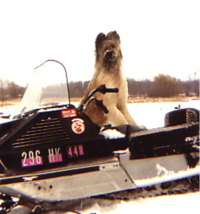Overcoming Cabin Fever Video
DOGS AND THEIR HUMANS love fresh snow fall. But high wind, dangerous ice, falling temps or long stretches of shortened and sunless days make radiators more inviting than sidewalks. The good news is that you can stay in or go out and still keep your dog content and happy.
This article is adapted from “Overcoming Cabin Fever” in Hip Ideas for Hyper Dogs
IF YOUR DOG IS SUFFERING from cabin fever in the winter (and what dog isn’t?), here are some fun and easy exercise options for just about anyone – including those who are eager to embrace the elements head-on, as well as those who prefer to go into hibernation mode at this time of year.
SNOW SPORTS: Want to take advantage of the snow? Grab your dog and the right equipment and you’ll be all set. Just be sure to bring along some water for your dog if you’ll be out for an hour or more; dehydration can be a problem in winter, too, and running through the snow can be very taxing.
SNOWSHOEING: Anyone who can walk can snowshoe, and the shoes themselves can be had fairly inexpensively online or via classified ads. All your dog needs is some basic obedience training. And it’s great exercise for both of you.
CROSS-COUNTRY SKIING: There’s no better way to give yourself, and your dog, a good cardiovascular workout. If you’re skilled, and you have good off-leash control over your dog, take him or her along next time you hit the trails – a good time will be had by all.
SKIJORING: For a little more excitement with a hyper dog weighing 30 pounds or more, you might want to give skijoring a try. It’s an adaptation of cross-country skiing that allows your dog to do the heavy pulling – and it sometimes means exhilarating speeds. All you’ll need beyond your cross-country gear is a skijoring belt, sled-dog racing harness and tow line (all available online or at local sports-supply stores). Assuming that you’re a good skier and your dog has decent obedience skills, you’ll be all set.
INDOOR FUN: You can give your dog a good workout and a good time indoors, too. Here are some idea-starters.
RETRIEVING: Does your dog love to play ball? Satisfy her retrieving instinct by launching a ball or another toy up or down the stairs and letting her do what comes naturally. You don’t even have to worry about overexerting her; she’ll quit when she gets tired. A word of caution: if the steps are slippery, install a runner or non-skid pads before the first toss. And don’t do this if your dog is arthritic – but you knew that already.
TUG-OF-WAR: This is a game dogs naturally delight in, so if yours can play it responsibly, go for it. Just be sure to inject a little discipline into the game every now and then, giving him a sit, down, or heel command in the midst of a good tug, and enforcing it. If you find that it’s teaching him some bad habits – like unwillingness to relinquish items on command – skip this game entirely.
RAPID-FIRE COMMANDS: Here’s a great way to calm your dog down while increasing his responsiveness and exercising his mind. It’s also a perfect technique precluding over-exuberance when someone comes to the door. Here’s what to do: Snap a leash on his collar. Then deliver, and enforce, a series of commands as quickly as he can carry them out. Use any combination of commands such as sit, down, stay, come, heel, and sit up, mixing them up and imparting a sense of great urgency with each one. Expect that you’ll have to use a few corrections to ensure a lively cadence. Once you’ve captured his full attention, praise him and release him. If he loses emotional control, repeat the exercise.
STALKING, CHASING, POUNCING AND PLAYING: Ever feel like acting as goofy as your dogs does? Go right ahead! Attach a leash so you can regain decorum if necessary, and join her on the floor to get silly: Pretend you’re a cat and stalk her. Pounce on her. Play tag or tug-of-war. Tease her with a toy and then toss it out and race her for it. Or challenge her to a race over an improvised indoor race course. Throw in some obedience commands to maintain control over the situation; when she returns to obedience mode, let the games begin again. It’s like developing an on/off switch for hyper-excitability and obedience.
PLAY DURING TRAINING: To further refine that on/off switch, and have a lot of fun in the process, turn your indoor obedience sessions into “controlled play.” Practice old commands and teach new ones, frequently inserting bursts of whatever he likes to do best – chasing, hiding, pouncing, and light scratching, for instance. The moment she begins to lose control, go back to your commands.
HIDE and SEEK: If this was one of your favorite childhood games, why not play it again? Simply tell your dog to stay, leave the room, hide, and issue the “come” command. Or if you have an accomplice handy, such as a young daughter, let her do the hiding while you ask your dog, “Where’s Susie?” Or try hiding a favorite toy or treats – even a non-sporting dog will enjoy that sort of hunt! This gives you the added pleasure of watching his excitement as he searches out the hider.
WACKY RECALLS: Whenever the spirit moves you, grab your dog’s attention with a sharp clap or by calling “Hey!” or “Come!” Then take off down the hall, up the stairs, and duck into a dark corner to hide. You’ll fail and she’ll be delirious with joy. Do this about every fourth time you call her, and you’ll be fine-tuning her recall skills so well that she should soon be racing to your side every time she hears you call “come!”
 INDOOR TRAINING TIPS: Are you using frigid weather as an excuse to postpone training your dog? DON’T! It is the best opportunity to improve your dog’s behavior if you know how to do it in the comfort of your home. I offer private In-home lessons but you can do the following exercises on your own, starting today:
INDOOR TRAINING TIPS: Are you using frigid weather as an excuse to postpone training your dog? DON’T! It is the best opportunity to improve your dog’s behavior if you know how to do it in the comfort of your home. I offer private In-home lessons but you can do the following exercises on your own, starting today:
- Heeling practice — Weave through rooms and around furniture. Move quickly. Demand prompt responses and your dog will be SO proud dog for his improved listening skills (I may be projecting but, once you do this, you’ll see what I mean!)
- Sit stays – heel over to the fridge or dishwasher, open it and shuffle through the contents as you keep one eye on your critter ready to enforce. Also, leash your dog when you expect visitors — that’s a perfect opportunity for practice the ‘sit stay,’ too
- Recall (come command) — keep your dog leashed indoors and, when he’s completely engrossed in his own endeavors, call “come” as you back up, praise, and pull him in
AND THAT’S ONLY THE BEGINNING! Want to learn more? I offer group classes, private consultations, and workshops. CLICK here to see the current Amiable schedule and to enroll.
WANT TIMELY TIPS ON BETTER BEHAVIOR? Check out Overcoming Canine Cabin Fever. Have a dog-gone great New Year and call/text (414-289-7785) or email ([email protected]) anytime!
Want more great ideas for entertaining, exercising and training your dog? Consult Hip Ideas for Hyper Dogs (Wiley) — and get ready to enjoy new levels of communication and closeness with even the most hyperactive canine!
By Amy Ammen and Kitty Foth-Regner
This article is adapted from Hip Ideas for Hyper Dogs
Written by Amy Ammen and Kitty Foth-Regner
Copyright by Wiley Publishing, Inc.
All rights reserved.
Contact Amy
Have a question? Please use this form to contact me about your goals, concerns, pertinent details, physical limitations, dog’s background and other topics.
Ready to Enroll?
Visit my services page and enroll in the group class, private lesson or workshop you’d like to attend. I will contact you upon enrollment and provide additional details.
